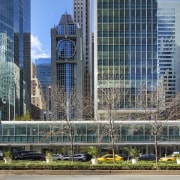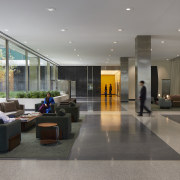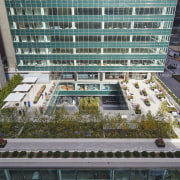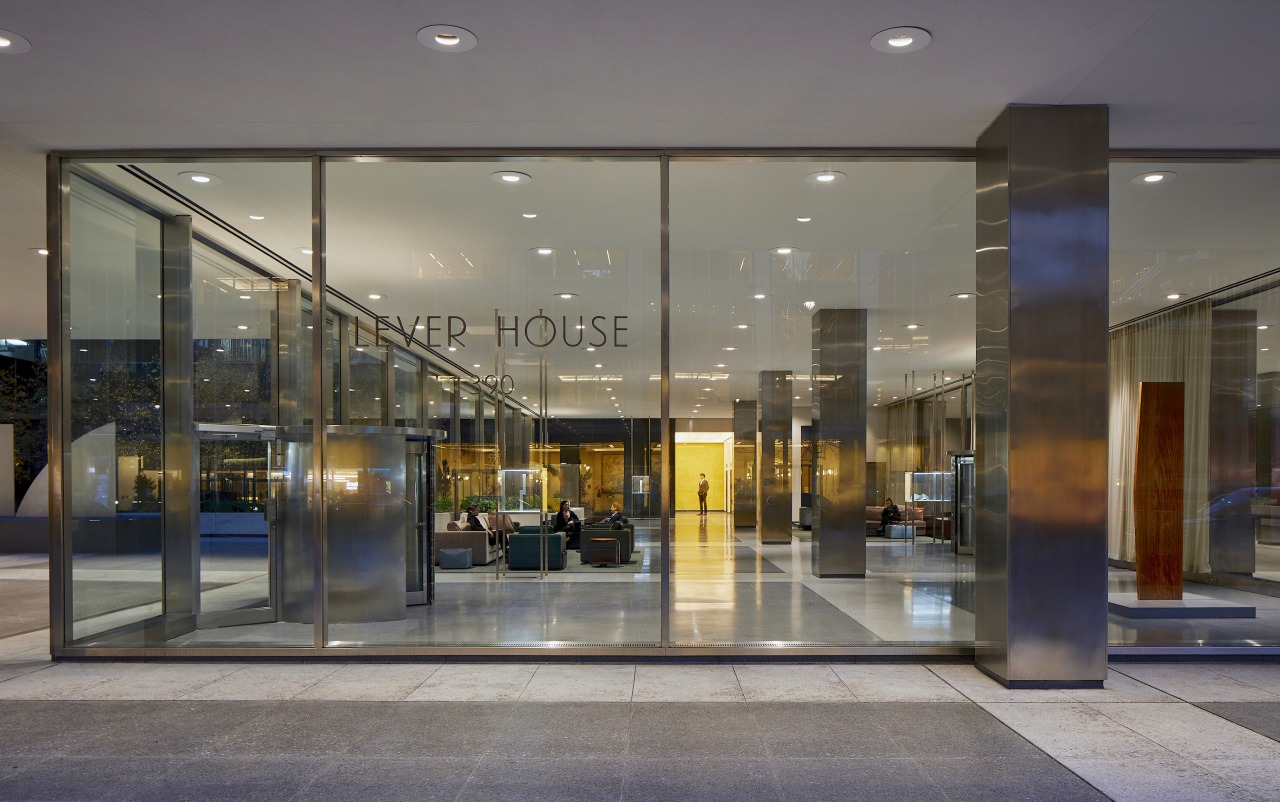Reactivated for the 21st century
SOM's restoration of Lever House, a NYC landmark, revitalises the building for modern offices while preserving its iconic Mid-century design
Refurbishing/upgrading architects: Skidmore, Owings & Merrill (SOM)
From the architects:
Commercial office design was forever changed across America with Lever House’s completion in 1952 in New York.
Few had seen anything like it: in a city characterised by masonry and brick, the blue-green glass and steel facade reimagined how an office building could look and feel.
It demonstrated that successful office design prioritises the community; instead of designating the ground floor for retail, SOM created a public space.
Rather than maximising rentable floor area, SOM placed the office floors – arranged in a 22-storey, vertical slab – atop an elevated, horizontal base and set them perpendicular to Park Avenue on the northern part of the site.
This design brought light and air down to the open plaza below, establishing a new relationship between the office and the public realm.
From a distance, the tower looks just as it did when it opened.
SOM revisited the building in 2001 to completely restore its facade.
The curtain wall had been so far ahead of its time when constructed that its mullions had corroded, causing adjacent glass panes to crack and necessitating a new, high-performance facade with materials that were identical in appearance to the original, Mid-century metal and glass.
But after about 70 years of operation, some of the building’s other original elements began showing their age.
Many materials at the ground floor and third level terrace were damaged or deteriorating, while inside the office slab, mechanical systems original to the building were long past their design life.
Two decades after the facade work, SOM has returned to this Modernist icon to complete its restoration under the leadership of developers Brookfield Properties and WatermanCLARK who assumed control of the tower in 2020.
Such stewardship of a single building, by one firm over a seven-decade period, is a rarity in the architectural profession.
Alongside Brookfield Properties and WatermanCLARK, and in partnership with the Landmarks Preservation Commission, which made Lever House the city’s first modernist landmark in 1982, SOM has restored the primary public and private spaces to their original glory, and provided key infrastructural upgrades that are significantly improving the building’s energy performance.
This renovation and restoration, completed in 2023, revitalises Lever House and makes it once again Park Avenue’s premier boutique office building.
In the plaza, the pre-existing, non-original paving was in poor condition, and has been fully replaced by a durable, cast-in-place concrete, matching the design of Lever House’s original paving: a series of dark grey surfaces separated by a grid of light grey stripes, which follow the rhythm of the building’s stainless steel columns.
The water-damaged plaster ceiling, which carries from the outdoor plaza into the lobby, has been replaced in kind with new, higher performing plaster.
Throughout the site, the original stainless steel-clad columns, which were damaged over time, are now restored and refinished.
The long black limestone wall – which acts as a backdrop to both the plaza and lobby – has been re-honed, polished, and cleaned.
The white marble, which encloses stair towers within both the plaza and the lobby, has been reset, honed, and repaired.
Inside, the lobby’s original terrazzo flooring has likewise been repaired and refinished.
Together with the new exterior paving, this refurbishment creates a renewed sense of continuity from the outdoor space as tenants and visitors transition to the interior.
All around the lobby, SOM implemented a plethora of updates.
Within the lobby’s enclosure, stainless steel mullions were refurbished and cracked glass was replaced.
A glass mosaic tile wall in the elevator vestibule has been cleaned and repaired, while the luminous ceiling above features an upgraded, diffused lighting system to improve brightness and energy efficiency.
The cumulative effect of all these efforts, while subtle, transforms the arrival experience at the building and creates a place that is both renewed and reminiscent of the landmark’s appearance in 1952.
SOM also added one discreet opening in the black limestone wall.
Previously, staff from the restaurant on site had to walk through the office lobby to reach outdoor seating located in the plaza.
To improve functionality, SOM designed a pair of new stainless steel doors, detailed to match adjacent original doors in the limestone wall, to create a direct connection – significantly enhancing circulation throughout Lever House’s ground level.
SOM’s interventions continue to the higher floors, most notably with new landscaping.
From the plaza and lobby-level planter to the third-floor terrace, Lever House’s landscaping – most of which has changed over the years – now visually unites with new birch trees throughout.
The white barks of these new trees create a beautiful composition against the black limestone wall, and harmonise with new paving on the 1208m² third-floor terrace.
All the pre-existing, non-original red paving has been replaced with a more durable surface – a new, grey precast concrete paver, with dimensions that recall the size and shape of the original paving, is more complementary in colour to the building’s blue-green glass.
At the perimeter of the terrace, the landscaping now features new shrubs, flowers, and perennials to frame views of Park Avenue.
Moving to the office floors inside, a series of sweeping changes to the mechanical systems contributes to new LEED Gold and WELL Platinum certification targets.
For seven decades, Lever House used its original induction units.
SOM took out all these units, adding floor space along the walls and allowing ceiling heights to rise from 2.7m to 3m without affecting the appearance of the curtain wall from outside.
To replace the old induction units, SOM equipped the building with a modern, dedicated outdoor air system, new chillers, HEPA filters, and an automated building management system.
This new mechanical equipment, along with a 500-kilowatt generator, improved security systems, and modernised elevators, will maintain the landmark’s place as a Class A office space for decades to come.
SOM Partner Chris Cooper says the renovation reactivates Lever House for the 21st century.
“We’ve restored the plaza and podium to its original 1952 glory while comprehensively overhauling the mechanical systems.
The result is a landmark that is both renewed and reminiscent of its Mid-century splendour – with revamped outdoor spaces, more natural light inside, and an efficient use of energy,” says Cooper.
Lever House’s renovation and restoration is a primary example of the potential of improving our existing buildings.
As our Mid-century built environment continues to age, projects like this will become far more important – making SOM’s work on Lever House a precedent for extending the life, vitality, and sustainability of a landmark in light of a changing climate.
Credit list
Rejuvenating architect
Interior design
Preservation consultant
Designed by: Skidmore, Owings & Merrill (SOM)
Story by: Trendsideas
Photography by: Lucas Blair Simpson © SOM
Home kitchen bathroom commercial design













